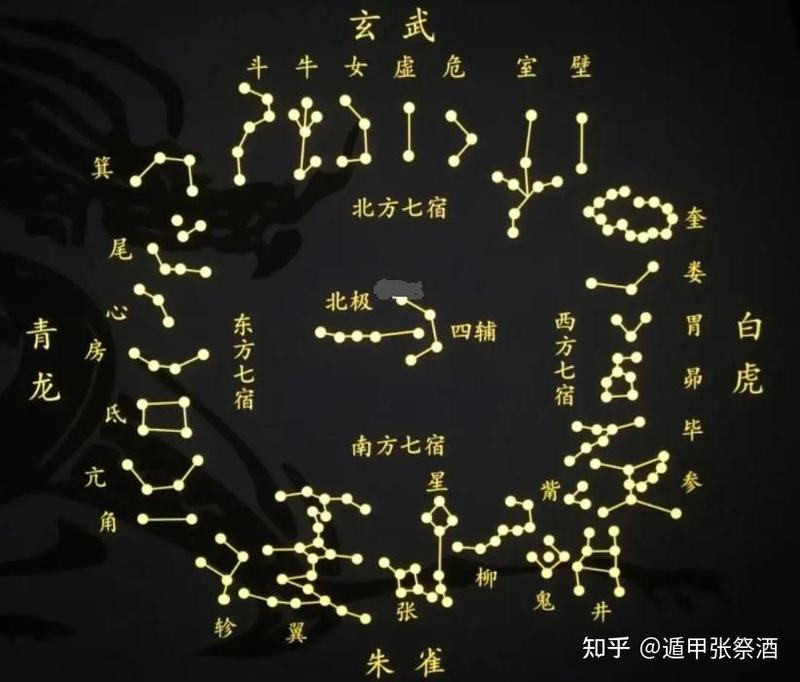28 Lunar Mansion (constellation)
Zhang Heng’s "Ling Xian", divided the sky into four celestial quadrants (四象)
Jacely Voon
7/2/20252 min read


🌌 Explanation of the 28 Lunar Mansions
In Zhang Heng’s "Ling Xian", the sky is divided into four celestial quadrants (四象):
Green Dragon (青龙) in the East (Spring)
White Tiger (白虎) in the West (Autumn)
Red Pheonix/Vermilion Bird (朱雀) in the South (Summer)
Black Tortoise (玄武) in the North (Winter)
🐉 Eastern Palace – Green Dragon (Spring)
Includes: Horn (角), Neck (亢), Root (氐), Room (房), Heart (心), Tail (尾), Winnowing Basket (箕)
Horn (角): Also known as Heaven’s Gate, one of the two stars crossed by the ecliptic. It’s often aligned with the Sun, Moon, and planets. Symbolises beginnings and thresholds.
Neck (亢): The dragon’s throat; represents dignity and strength.
Root (氐): The dragon’s forelegs; signifies stability and progress.
Room (房): Symbolises celestial palaces or treasuries, connoting abundance and prosperity.
Heart (心): The dragon’s heart; bright and vibrant, symbolising passion and vitality.
Tail (尾): Agile like a dragon’s tail; implies transformation and opportunity.
Winnowing Basket (箕): Resembles a grain winnow; symbolises harvest and purification.
🐅 Western Palace – White Tiger (Autumn)
Includes: Legs (奎), Bond (娄), Stomach (胃), Hairy Head (昴), Net (毕), Beak (觜), Three Stars (参)
Legs (奎): Resembles a pair of thighs; stands for stability and strength.
Bond (娄): Means "to gather"; symbolises convergence and prosperity.
Stomach (胃): Associated with nourishment and satisfaction.
Hairy Head (昴): Denotes youth and vitality.
Net (毕): Cited in classic texts such as Book of Rites and Shiji, it appears like crossed lines (a net) and signals the arrival of rain when the moon passes it.
Beak (觜): Explained in Shuowen Jiezi as a bird's sharp beak; the three stars resemble a pointed mouth above the shoulders of Orion.
Three Stars (参): Known for its striking brilliance from winter to early summer; symbolic of strength and crisis-handling. In some texts, also associated with the myth of Emperor Gaoxin.
🐢 Northern Palace – Black Tortoise (Winter)
Includes: Dipper (斗), Ox (牛), Girl (女), Void (虚), Rooftop (危), Room (室), Wall (壁)
Dipper (斗): Also called the Southern Dipper; similar in shape to the Big Dipper but less bright. Symbolises destiny and lifespan.
Ox (牛) & Girl (女): Also known as Cowherd and Weaving Girl (linked to the Qixi love legend). Found inscribed on lacquerware from the Warring States period, confirming their ancient names.
Void (虚): From Shuowen, originally meaning "hill" or abandoned city. Central northern mansion, associated with metaphysical concepts and autumn clarity.
Rooftop (危): Described in Shiji Tian Guan Shu as roof-shaped, symbolising elevation and defense.
Room (室) & Wall (壁): Originally a single mansion called Yingshi (Celestial Residence). Later split into two, representing structures and security. Used to mark the time for construction after harvest in autumn.
🔥 Southern Palace – Red Phoenix/Vermilion Bird (Summer)
Includes: Well (井), Ghost (鬼), Willow (柳), Star (星), Net (张), Wings (翼), Chariot (轸)
Well (井): Described in Shiji as "the mansion of water matters", shaped like a well, located between Gemini and Orion.
Ghost (鬼): Also called Chariot of Ghosts, four stars in a square like a cart base. Symbolises spirits, ancestors, and rituals.
Willow (柳): Named for its bird-beak shape; consists of eight stars curved like a hanging willow or bird beak.
Star (星): According to Book of Rites, appears in early spring. In Shiji, it's linked to urgent matters due to its location near the celestial snake’s heart.
Net (张): "Zhang" also means "to stretch" or "display". The constellation resembles a bow or open snare.
Wings (翼): With 22 stars, it resembles the open wings of a bird. Associated with the southern Vermilion Bird.
Chariot (轸): Shaped like a carriage, contains four central stars and two side ones representing wheels. Linked to the Corvus constellation.
